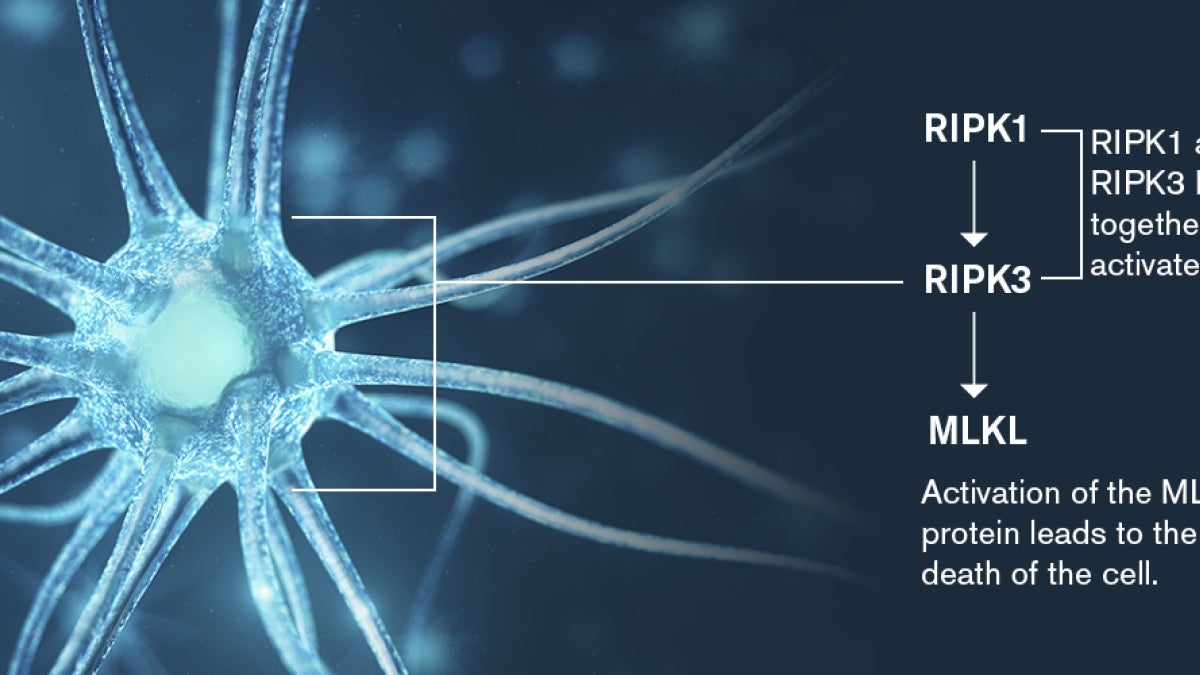New NIH grant to probe secrets of cell death in Alzheimer’s

Necroptosis, a form of programmed cell death, relies on 3 critical proteins. RIPK1 and RIPK3 bind to form a structure known as the necrosome. Then, the protein MLKL is activated, resulting in perforation of the cell membrane and cell death. The process is believed to play a major role in the neuronal loss characteristic of Alzheimer's disease. Graphic by Shireen Dooling
Most neurons in the human brain live out their lives, enduring the processes of aging before eventually dying. Some, however, choose a more violent route: suicide.
In a new project, researchers hope to better understand a form of programmed cell death known as necroptosis, believed to play a crucial role in the massive destruction of neurons typical of Alzheimer’s disease.
The new $3.2 million, five-year grant from the National Institutes of Health, titled "Necroptosis as a novel mechanism underlying neurodegeneration in Alzheimer’s disease," will investigate an important contributor to neuronal loss. The investigations could pave the way for effective therapeutics capable of blocking the necroptosis pathway and slowing or arresting some of the cell death characteristic of the disease.
According to Salvatore Oddo, principle investigator of the new project: “We anticipate that our findings will spur a new area of research in the ADAlzheimer’s disease field focused on developing new therapeutic strategies aimed at blocking its activation.”
Oddo is a researcher in the ASU-Banner Neurodegenerative Disease Research Center and an associate professor at ASU’s School of Life Sciences.
Fate of cells
Alzheimer’s disease is one of the most darkly inscrutable human disorders and remains the only leading killer that cannot be prevented, treated or cured. Yet one thing has been clear from the first diagnosis of the memory-stealing ailment, over 100 years ago: Alzheimer’s disease is a prolific destroyer of brain cells. A postmortem brain that has been ravaged by the disease will appear markedly reduced in volume, due to the brain’s relentless insurgence against its own neurons.
Until now, however, researchers have remained puzzled as to just how the disease attacks and destroys cells in the brain — a foundational issue in Alzheimer’s research. The new project will explore this mystery, investigating a unique pathway of destruction, necroptosis.
Historically, cell death has often been described in two primary forms, apoptosis, (a programmed cell suicide common in early development and other normal physiological processes), and necrosis, an uncontrolled cell death usually resulting from illness or injury. New research has underlined the importance of necroptosis, a programmed form of necrosis.
Creation and destruction
The human brain is known to undergo dramatic transformations over the course of a life, more than any other organ in the body. Programmed cell death, while devastating in the case of neurodegenerative diseases like Alzheimer’s disease, plays an essential role in many biological processes, particularly during normal embryonic brain development.
In the first few years of a newborn child’s life, the brain creates roughly 1 million new connections per second. This extravagant overproduction of neurons is followed by a phase of radical pruning to complete the early brain’s formation. Programmed cell death of this kind, known as apoptosis, is critical for many other aspects of embryonic and early fetal development.
Salvatore Oddo is a researcher in the ASU-Banner Neurodegenerative Disease Research Center (NDRC) and a professor in ASU's School of Life Sciences.
The process of programmed cell death, however, can take a tragic and malevolent turn should it occur in the adult brain, leading to the telltale signs of neurodegeneration: severe memory loss, disorientation, declining motor abilities and speech functions and, eventually, death.
As Alzheimer’s disease continues its sinister trajectory, the urgency for effective treatments and strategies of prevention intensifies. Without a significant breakthrough, the disease is on track to afflict 20 million people in the U.S. alone by 2050. In addition to shattering so many lives, the epidemic could deal an economic knockout blow to the health care system, with estimated costs topping $1 trillion.
Aging brain
While the processes of aging are inevitable, their rate is not uniform among individuals. Further, researchers are unsure why some brain regions are more susceptible to degeneration or why some cells within a given region appear resistant to degradation and cell death.
Necroptosis activation is known to play an important role in multiple sclerosis and amyotrophic lateral sclerosis or ALS. Oddo and his colleagues have identified the first evidence of the activation of necroptosis in the case of Alzheimer’s disease and linked the advance of necroptosis to the increasing severity of cognitive decline and neuronal loss, which are hallmarks of the disease.
The effects of necroptosis are clear from the examination of affected neurons. The process appears to attack neuronal membranes, which become perforated, causing cells to lose function, eventually bursting from inside. In earlier research, Oddo has explored the molecular mechanisms giving rise to necroptosis.
Entering the necrosome
The process begins when a key protein, RIPK1 binds with a second protein, RIPK3, forming a complex known as the necrosome and completing the first ominous phase of necroptosis.
Next, the necrosome activates a third protein, MLKL. It is this final protein that will complete the necroptosis pathway, delivering the coup de grace to affected neurons. MLKL appears to deliver the lethal blow in part through an attack on the cell’s energy storehouse, the mitochondrion.
Oddo’s group measured levels of RIPK1 and 3 and MLKL in postmortem brains stricken with Alzheimer’s disease. Within the temporal gyrus, a known hot spot for cell loss in Alzheimer’s, they found that during necroptosis, these diagnostic markers were increased. Necroptosis activation was also shown to correlate with the abundance of Tau, one of two key proteins (along with amyloid beta) forming the characteristic plaques and tangles long associated with the disease.
Further, necroptotic protein levels in autopsied brains were shown to negatively correlate with the earlier scores achieved by Alzheimer’s patients on the Mini-Mental State Examination (MMSE), a widely used evaluation of cognitive health.
Having established compelling links between necroptosis, cell loss and cognitive decline in Alzheimer’s disease, the researchers designed a therapeutic proof of concept treatment, which was successfully demonstrated in a mouse model of the disease. A pharmacological blocking of the key necroptosis binding event of RIPK1 with RIPK3 prevented the formation of the necrosome, leading to reductions in cell loss and improved performance by the mice on spatial memory-related tasks.
The NIH project will further the exploration of the necroptosis pathway and investigate other potential proteins implicated in programmed cell death, which could provide additional targets for therapeutic intervention and new hope for preserving neurons.
The research is supported by NIH grant R01AG057596
More Science and technology

From food crops to cancer clinics: Lessons in extermination resistance
Just as crop-devouring insects evolve to resist pesticides, cancer cells can increase their lethality by developing resistance to…

ASU professor wins NIH Director’s New Innovator Award for research linking gene function to brain structure
Life experiences alter us in many ways, including how we act and our mental and physical health. What we go through can even…

ASU postdoctoral researcher leads initiative to support graduate student mental health
Olivia Davis had firsthand experience with anxiety and OCD before she entered grad school. Then, during the pandemic and as a…
